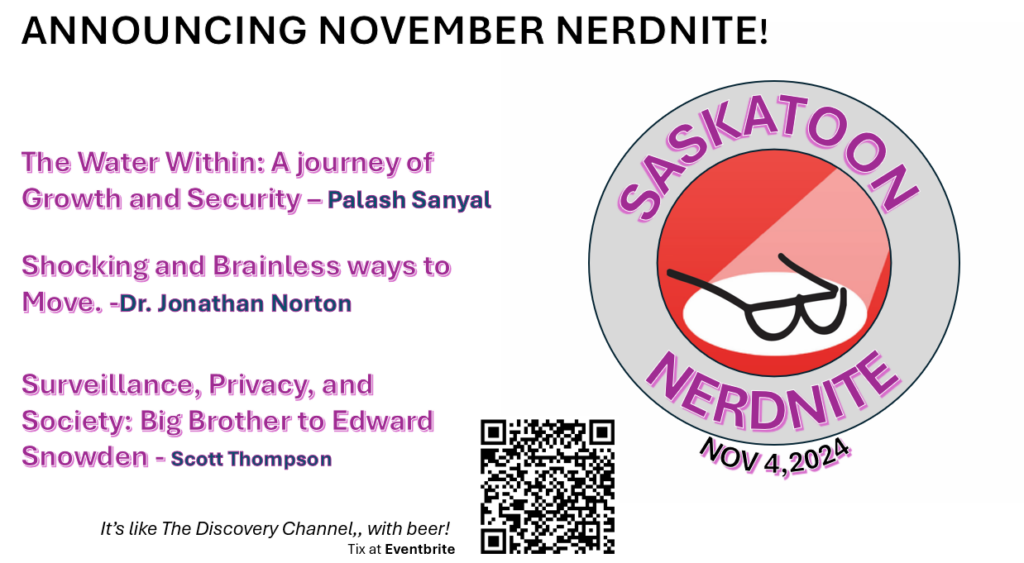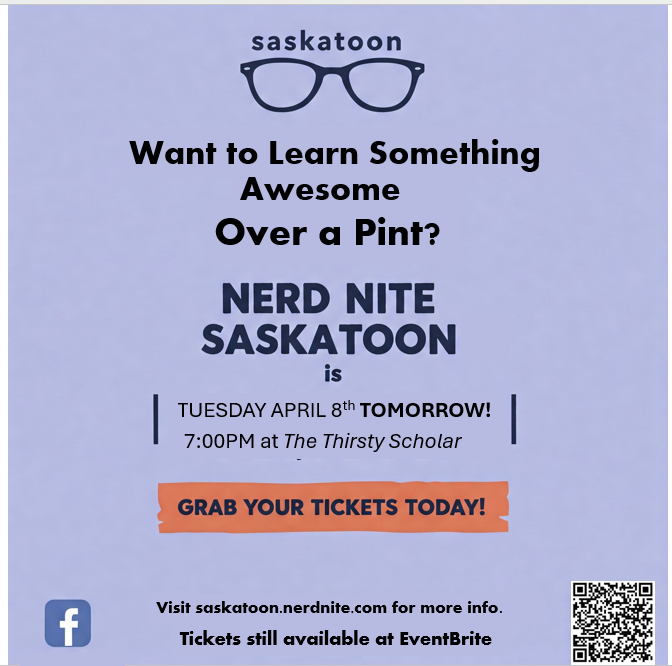
Saskatoon NerdNite 5 is Tomorrow!

Saskatoon Nerdnite April 8 Full Lineup!

Saskatoon: An Unlicensed History – Jeff O’Brien
Although founded by teetotallers and Temperance activists, Saskatoon, booze, and the regulation thereof, have a long history together. City of Saskatoon Archivist Jeff O’Brien looks at the story of Prohibition and a century of liquor and liquor legislation here in the Paris of the Prairies, covering the years from 1882-1982.
Jeff O’Brien was born in Saskatoon and raised in Regina where, despite his best efforts to the contrary, he received an undergraduate degree in Canadian history. He went on to earn a master’s degree in archival studies from the University of British Columbia before returning home to Saskatchewan where he eventually settled down as the City of Saskatoon Archivist in 1997. As the City Archivist, Jeff believes in bringing history out of the archives and into the community. In 2006, he co-authored the book Saskatoon: A History in Photographs. He is a regular contributor to Saskatoon HOME and Prairies North magazines, and to our own historical journal, the Saskatoon History Review. He is frequently called on to speak to community groups, city classrooms, and at local events—like this one. He can also often be seen and heard on radio and TV here talking about the history of his beloved city. In 2023, he was awarded the Queen’s Jubilee medal in recognition of his work in this area.
Technology Doping in Sport – Dr. Sean Maw
Pretty much everyone has heard of illegal blood doping and drug doping in sport, but have you heard of technology doping? It’s the same basic idea i.e. get an unfair edge that the other competitors won’t have, but this time using tech! We’ll go through some examples/case studies and talk about the impacts of technology doping in sport. We’ll also talk about why this is the “cheating” that sports generally don’t talk about (except for maybe curling) and some people just don’t care about, though they should. For the finale, we’ll talk about where technology is leading us in sport, because we’re sure not leading it.
Dr. Sean Maw is a professor in Engineering at the University of Saskatchewan,where he runs the First Year Engineering Program and teaches design. His research is focused on engineering education, and on sports engineering (hence the Technology Doping talk!). Sean is a bit unusual and hasn’t really grown up yet. He is an active soccer player, swing/ballroom dancer, and ice cream maker. He’s announced speed skating at two Winter Olympics, climbed Kilimanjaro, and rafted down the Nahanni. He designed crash pads for the 2010 Vancouver Winter Olympics, as well as skin suits for the 2006 Torino Winter Olympics. currently researches the physics of curling, trying to solve one of the few modern mysteries in Newtonian physics: why curling stones curl the way they do. Science still doesn’t know.(stay tuned for an upcoming Nerdnite!)
Genomics, Cattle, and Solar Powered Vaccines – Dr. Grant Woronuk
By mixing cocktails of enzymatic probes to illuminate key sections of DNA, Grant Woronuk turns up the (nucleo)base on cattle. Using such tech to identify cattle capable of efficient growth, enabling feedyards to commit fewer grazing lands to growth, and endearing him to the industry such that they have enlisted him to solve their biggest unsolved problems…. widespread use of antibiotics in their animals. Our solution: edible vaccines packed into the animals’ feedcrop. In formulating this solution, we targeted an evolutionary nuance that results in crops that produce maximal vaccine in a safe and environmentally responsible manner. This talk will highlight some of the processes, problems, and the future of edible vaccination of animals with plants!
Dr. Grant Woronuk is the Lead Research Scientist of Quantum Genetix responsible for developing molecular genetics testing and now leading a transgenenics team for novel crop development. Somehow, Grant emerged from his academic training with a diverse conceptual and applied skillset: a PhD in transcriptomics of chilled legumes from Saskatchewan; an MSc from Guelph in molecular signaling direct pre-pollen to become grown canola without fertilization; a fellowship from UBC in the ‘omics’ of perfume biosynthesis; and a largely forgotten BSc that focused on neuroscience from Lethbridge. If there’s any consistency with this guy, perhaps it’s the belief that big impacts can be made when we understand the small stuff.
Tickets at Eventbrite

The first book from Nerd Nite (Global) has just been released as well!! But you can see the real thing live on Apr 8!
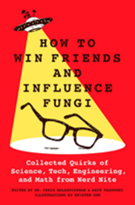
Final Speaker for NN5!
Genomics, Cattle, and Solar Powered Vaccines – Dr. Grant Woronuk
By mixing cocktails of enzymatic probes to illuminate key sections of DNA, Grant Woronuk turns up the (nucleo)base on cattle. Using such tech to identify cattle capable of efficient growth, enabling feedyards to commit fewer grazing lands to growth, and endearing him to the industry such that they have enlisted him to solve their biggest unsolved problems…. widespread use of antibiotics in their animals. Our solution: edible vaccines packed into the animals’ feedcrop. In formulating this solution, we targeted an evolutionary nuance that results in crops that produce maximal vaccine in a safe and environmentally responsible manner. This talk will highlight some of the processes, problems, and the future of edible vaccination of animals with plants!
Dr. Grant Woronuk is the Lead Research Scientist of Quantum Genetix responsible for developing molecular genetics testing and now leading a transgenenics team for novel crop development. Somehow, Grant emerged from his academic training with a diverse conceptual and applied skillset: a PhD in transcriptomics of chilled legumes from Saskatchewan; an MSc from Guelph in molecular signaling direct pre-pollen to become grown canola without fertilization; a fellowship from UBC in the ‘omics’ of perfume biosynthesis; and a largely forgotten BSc that focused on neuroscience from Lethbridge. If there’s any consistency with this guy, perhaps it’s the belief that big impacts can be made when we understand the small stuff.
Second Speaker in March/April Announced!
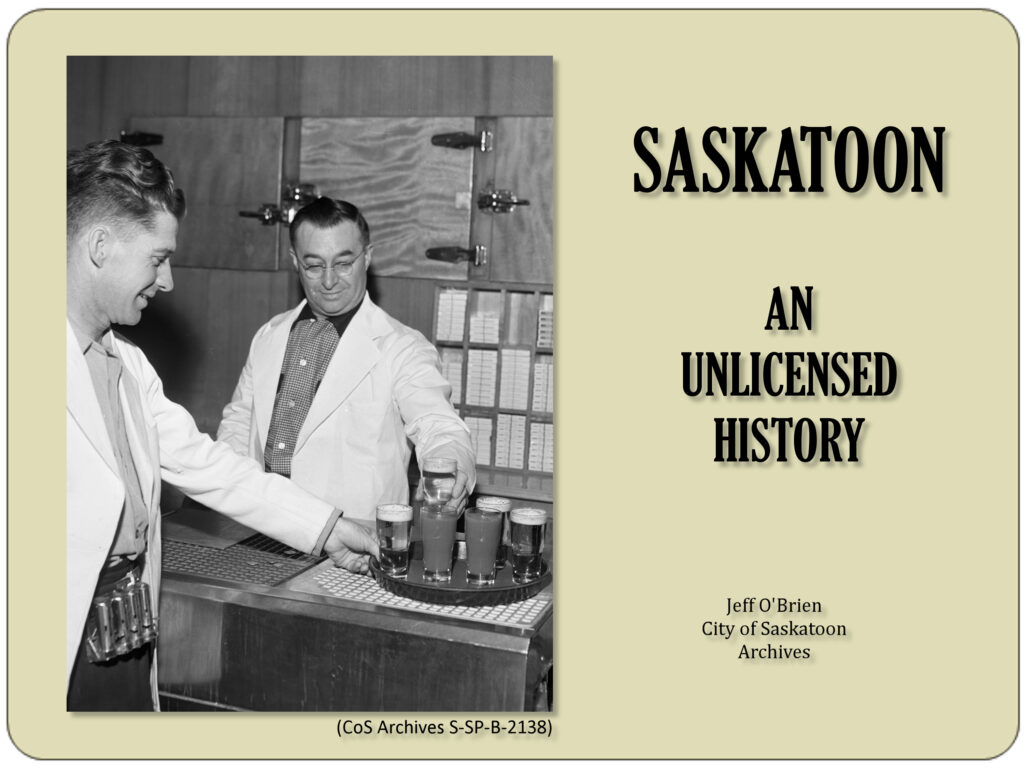
Saskatoon: An Unlicensed History
Although founded by teetotallers and Temperance activists, Saskatoon, booze, and the regulation thereof, have a long history together. City of Saskatoon Archivist Jeff O’Brien looks at the story of Prohibition and a century of liquor and liquor legislation here in the Paris of the Prairies, covering the years from 1882-1982.
Jeff O’Brien was born in Saskatoon and raised in Regina where, despite his best efforts to the contrary, he received an undergraduate degree in Canadian history. He went on to earn a master’s degree in archival studies from the University of British Columbia before returning home to Saskatchewan where he eventually settled down as the City of Saskatoon Archivist in 1997. As the City Archivist, Jeff believes in bringing history out of the archives and into the community. In 2006, he co-authored the book Saskatoon: A History in Photographs. He is a regular contributor to Saskatoon HOME and Prairies North magazines, and to our own historical journal, the Saskatoon History Review. He is frequently called on to speak to community groups, city classrooms, and at local events—like this one. He can also often be seen and heard on radio and TV here talking about the history of his beloved city. In 2023, he was awarded the Queen’s Jubilee medal in recognition of his work in this area.
First Speaker Announced for March/April
The date isn’t set yet, but you will want to hear this talk!
Technology Doping in Sport
Pretty much everyone has heard of illegal blood doping and drug doping in sport, but have you heard of technology doping? It’s the same basic idea i.e. get an unfair edge that the other competitors won’t have, but this time using tech! We’ll go through some examples/case studies and talk about the impacts of technology doping in sport. We’ll also talk about why this is the “cheating” that sports generally don’t talk about (except for maybe curling) and some people just don’t care about, though they should. For the finale, we’ll talk about where technology is leading us in sport, because we’re sure not leading it.
Dr. Sean Maw is a professor in Engineering at the University of Saskatchewan, where he runs the First Year Engineering Program and teaches design. His research is focused on engineering education, and on sports engineering (hence the Technology Doping talk!). Sean is a bit unusual and hasn’t really grown up yet. He is an active soccer player, swing/ballroom dancer, and ice cream maker. He’s announced speed skating at two Winter Olympics, climbed Kilimanjaro, and rafted down the Nahanni. He designed crash pads for the 2010 Vancouver Winter Olympics, as well as skin suits for the 2006 Torino Winter Olympics. He currently researches the physics of curling, trying to solve one of the few modern mysteries in Newtonian physics: why curling stones curl the way they do. Science still doesn’t know.
Announcing our January Speakers!
Tuesday January 21 @ The Thirsty Scholar -Doors at 6 – First Speaker at 7
An Insiders look into the Dirty Little Secrets of the Saskatoon Auto Industry – Kealy Cheyenne
Join Kealy Cheyenne as she delves into the gritty realities of the Saskatoon Automotive Industry, revealing insights and experiences from her extensive career spanning 2007 to 2022. In her upcoming podcast and novel, “Exit on the Left,” Kealy explores themes of resilience, ethics, and the complexities of a male-dominated industry. This talk will not only provide a compelling look at her journey through challenges and triumphs but will also offer practical advice on how to navigate car purchases, understand the implications of credit, and decode misleading offers and advertisements. Kealy doesn’t position herself as a protagonist; rather, she acknowledges her role within the very fabric she discusses, at times part of the problems she now aims to highlight. Attendees will gain a unique perspective on the automotive world, empowerment, and the power of speaking out, equipped with the knowledge to make informed decisions in their automotive engagements.
Anime, Cosplay, and all things Nerd in Saskatchewan – Annie Shadden
Details to follow as we dial the Awesome back to manageable levels!
Swiping, Scoring…and Settling Down? How Singles 19 to 91 Look for Love in (Un)usual Places – Sarah Knudson
We live in a world where we have access to thousands of potential romantic partners, yet more people than ever before are living alone and staying single. What’s going on? How do the relationship-minded hunt for love today, and what major roadblocks do they come up against? And is the road to relationships different for young adults and seniors—or does your grandma’s love quest resemble yours in more ways than you’d like to admit?
In this talk, we’ll explore how and why we look for love today, as well as the tools we use to chase our relationships goals. Through a mix of big data, heartfelt storytelling, and a dash of pop culture commentary, we’ll consider what happens on the road to love—from the downright embarrassing to the totally inspiring. What can we take away from broad relationship trends and in-depth narratives as advice for our own lives, whether we’re happily single, ready to mingle, or partnered? A whole lot, so let’s find out
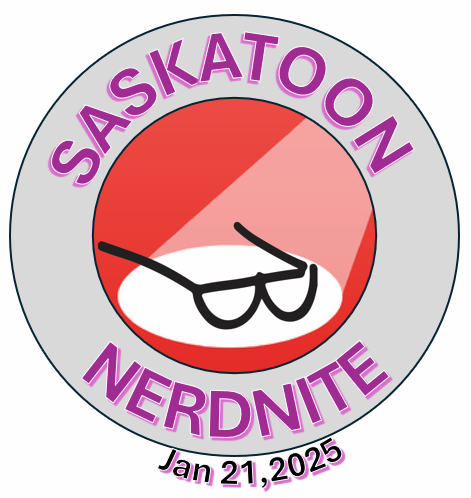
Return of Nerdnite in 2025
We are thrilled to share that Saskatoon Nerdnite is making a comeback! Mark your calendars for January 21st, 2025, as we kick off the year with an exciting evening filled with fascinating speakers, diverse topics, and, of course, refreshing pints. If you’ve ever wanted to take the stage and share your passion, now’s your chance! We are actively seeking presenters and still have spots available in our lineup. Don’t miss out on being part of this vibrant community event—reach out to us and secure your place!
AS REQUESTED!!
Here are the links and info from our amazing speaker, Scott Thompson, who spoke on Privacy, Security, and Edward Snowden!
All credit for these go to him, and do take the time to look into his book “Punch Drunk” (link and info at the bottom
Accessing Personal Data
All of these links should be active, but also the legislation only requires people to make a request for their personal data (see https://www.priv.gc.ca/en/privacy-topics/accessing-personal-information/accessing-your-personal-information/ )
Google – https://myaccount.google.com/intro
Apple – https://privacy.apple.com/account
Facebook – https://www.facebook.com/help/contact/180237885820953
Twitter – https://help.twitter.com/en/managing-your-account/accessing-your-twitter-data
Instagram – https://help.instagram.com/181231772500920
Uber – https://help.uber.com/riders/article/download-your-data?nodeId=2c86900d-8408-4bac-b92a-956d793acd11
Tinder – https://account.gotinder.com/login?from=%2Fdata
Snapchat – https://support.snapchat.com/en-US/a/download-my-data
Fitbit – https://www.fitbit.com/en-ca/legal/privacy-policy#your-rights-to-access
OkCupid – https://www.okcupid.com/legal/privacy#your-rights
My Book
Punched Drunk: Alcohol, Surveillance and the LCBO 1927–1975
https://www.academia.edu/18829451/Punched_Drunk_Alcohol_Surveillance_and_the_LCBO_1927_1975
AN OUTSTANDING EVENT!
Saskatoon NerdNite #3 was an outstanding success, highlighting thought-provoking talks from distinguished experts. Palash Sanyal enthralled attendees with his exploration of global water security, emphasizing the need for mindset transformations to drive progress. Jonathan Norton offered a compelling view on spinal implants, bringing hope for mobility restoration in the injured. Scott Thompson fascinated the audience with insights on our proximity to Edward Snowden, illuminating modern security measures. The event underscored the impact of knowledge exchange and innovation.
Saskatoon NerdNite will continue in January after everyone recovers from December, but in the meantime, follow us on Facebook and X to hear some of the best nuggets from the event!
https://www.facebook.com/groups/468844325618170
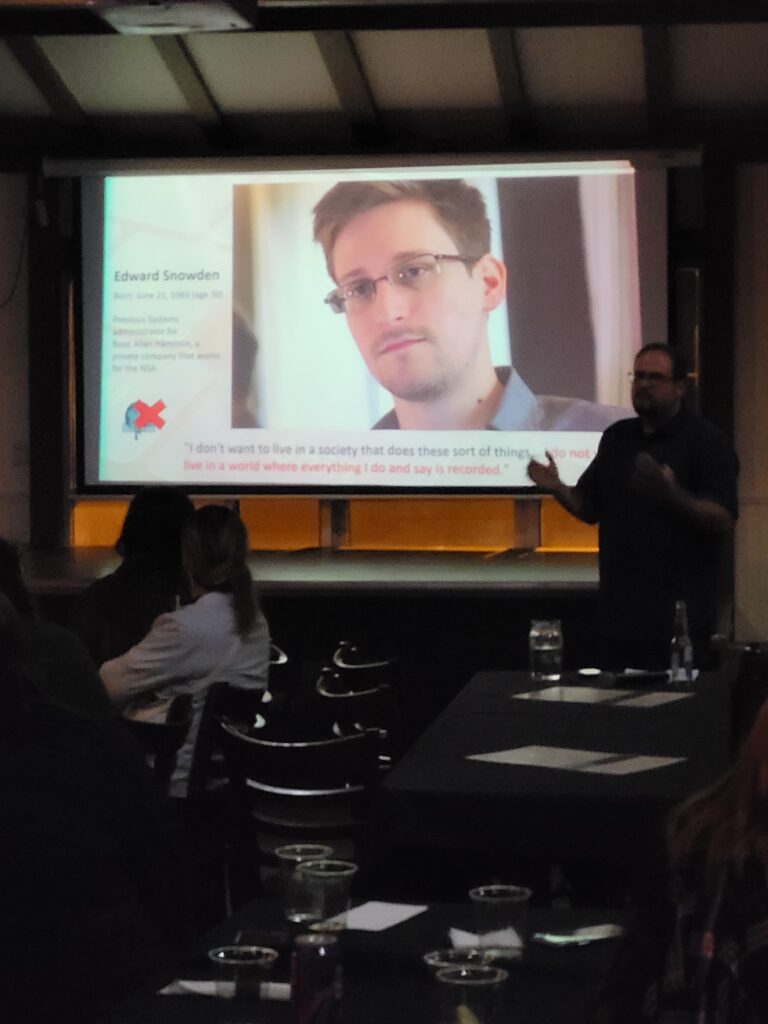
Lucky Number 3 Saskatoon NerdNite WOW! What a Lineup!
